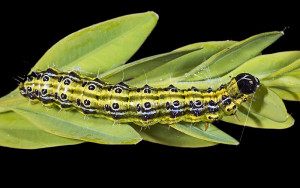 Since Aristotle many scientists have considered plants robotic, rather than vital intelligent beings. Darwin did not subscribe to this view and published a book about intelligent plant movement where he called the root the plant’s brain. Recently, an excellent book summarizing the current data on plant intelligence, Plant Behavior and Intelligence, was written by Anthony Trewavas, emeritus professor at the University of Edinburgh. This book has a wealth of details related to intelligent plant behavior described in this post. Plant intelligence update 2015 includes exiting recent research pushing the range of plant sensation, synthesis, decision making and activity.
Since Aristotle many scientists have considered plants robotic, rather than vital intelligent beings. Darwin did not subscribe to this view and published a book about intelligent plant movement where he called the root the plant’s brain. Recently, an excellent book summarizing the current data on plant intelligence, Plant Behavior and Intelligence, was written by Anthony Trewavas, emeritus professor at the University of Edinburgh. This book has a wealth of details related to intelligent plant behavior described in this post. Plant intelligence update 2015 includes exiting recent research pushing the range of plant sensation, synthesis, decision making and activity.
It is now clear that plants are aware of other plants, microbes and their environment, synthesizing a very large amount of information and deliberately making changes to themselves, their neighbors and the land nearby for their benefit and the benefit of their families. They can remember 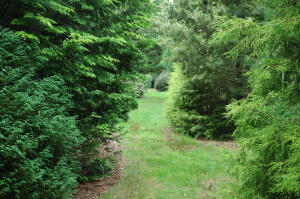 short term and for years and elaborately communicate with each other and many different friendly and unfriendly microbes. They engage in sophisticated defensive measures from the information they receive and synthesize. Plants are able to calculate the amount of oxygen and light and make adjustments when necessary. One of the problems with defining plant intelligence has been the slow movement of their behavior. Now with time-lapse video photography, plant behavior is much more obvious.
short term and for years and elaborately communicate with each other and many different friendly and unfriendly microbes. They engage in sophisticated defensive measures from the information they receive and synthesize. Plants are able to calculate the amount of oxygen and light and make adjustments when necessary. One of the problems with defining plant intelligence has been the slow movement of their behavior. Now with time-lapse video photography, plant behavior is much more obvious.
Recent research supports Darwin’s original notion of roots as the plant’s brain.
This post will describe new findings this year and summarize previous research. For more detailed information about the past research see posts Is Dodder the Most Intelligent Plant and Vital Plant Communication with Bacteria and Fungus.
Is the Plant’s Brain in the Root?
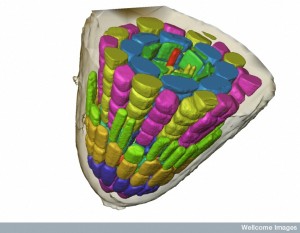 Recently, the many remarkable behaviors of roots have reinforced Darwin’s original idea that the root is the plant’s brain. The cap of the root is an organ that gathers sensory data and leads the way for the root to travel in the soil or other environments. It senses light, oxygen, nutrients, chemicals, pH, humidity and gravity. The meristem sits just behind the cap rapidly producing new cells for the root to grow. Next, the mysterious center, called the transition zone, produces the powerful hormone, auxin and is a source of electrical signals. Behind this is the region where cells elongate and bend in various shapes.
Recently, the many remarkable behaviors of roots have reinforced Darwin’s original idea that the root is the plant’s brain. The cap of the root is an organ that gathers sensory data and leads the way for the root to travel in the soil or other environments. It senses light, oxygen, nutrients, chemicals, pH, humidity and gravity. The meristem sits just behind the cap rapidly producing new cells for the root to grow. Next, the mysterious center, called the transition zone, produces the powerful hormone, auxin and is a source of electrical signals. Behind this is the region where cells elongate and bend in various shapes.
The transition zone produces vesicles to transport auxin, which is reminiscent of neurotransmitter function. It regulates the growth and direction of the plant. The vesicles are re-cycled, also, like neurotransmitters. This region uses a disproportionate amount of energy like the human brain. With the cap being the sensory system, the transition zone appears to be the brain and the elongation zone the muscles for plant movement.
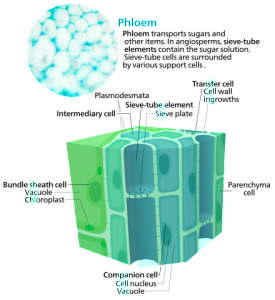 All root cells are capable of electrical signaling, often through the phoem vessels, which serve as a very large axon. This phloem channel runs from the new shoots to the tips of the root. More similarities to brains include plants producing neurotransmitters serotonin, GABA and melatonin. Medications that affect these neurotransmitters in humans, also, affect the flow of molecules in plants. By blocking the effect of the serotonin and melatonin, the root systems become disorganized.
All root cells are capable of electrical signaling, often through the phoem vessels, which serve as a very large axon. This phloem channel runs from the new shoots to the tips of the root. More similarities to brains include plants producing neurotransmitters serotonin, GABA and melatonin. Medications that affect these neurotransmitters in humans, also, affect the flow of molecules in plants. By blocking the effect of the serotonin and melatonin, the root systems become disorganized.
Roots exhibit many intelligent behaviors. They often bend before they meet rocks or obstacles to grow around them. Plants inhibit their roots only when they are surrounded by similar species to allow them to grow. Otherwise they won’t.
Root Structure and Intelligent Planning
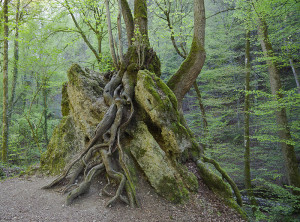 Communication has recently been observed between the root and the growing shoots to determine the amount of nitrogen and the exact root structure needed for the future growth of the plant. Nitrogen is the major limiting nutrient for plants and is acquired from the soil or by microbe factories. Plants need to coordinate the global question of how much nitrogen is needed for the entire plant and coordinate this information with the specific root structure that needs to be built to support this. The plant alters the root to obtain the most nitrogen using elaborate communication between the roots and the shoots.
Communication has recently been observed between the root and the growing shoots to determine the amount of nitrogen and the exact root structure needed for the future growth of the plant. Nitrogen is the major limiting nutrient for plants and is acquired from the soil or by microbe factories. Plants need to coordinate the global question of how much nitrogen is needed for the entire plant and coordinate this information with the specific root structure that needs to be built to support this. The plant alters the root to obtain the most nitrogen using elaborate communication between the roots and the shoots.
The communication occurs with a peptide signal in the root that recognizes the region around the plant with less nitrogen and communicates this information to the shoot. A return signal from the shoot expresses the projected growth of the shoots. After the return signal from the shoot to the root, the root can determine where to build up other root structures in areas that have greater amounts of nitrogen.
Many Intelligent Root Structures for Different Circumstances
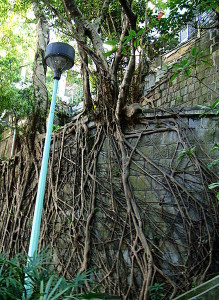
There are many kinds of roots, below the surface and in the air that produce different structures for specific circumstances. They absorb water and nutrients and store it for future food. They anchor and support the plant and send signals, such as cytokinin, to instruct the plant how fast the shoots should grow. They create the symbiotic relationship with fungi and bacteria to make nitrogen factories (see post)
Roots perceive light and gravity, and grow towards regions of minerals, water and away from dry areas. They, also, sense oxygen, nitrogen, phosphorus, sulphur, aluminum and sodium chloride.
Roots are powerful and can break foundations of concrete and lift sidewalks. They sense gravity and send the root down and the shoot up, except for some ivy plants that cling to buildings. The different structures of roots are used for different environments and different types of nutrients. The root appears to behave intelligently in creating patterns of branching,
Specific hormones and signal pathways are used to coordinate root architecture, including auxin to start and direct a root, cytokinins to regulate meristem dividing and lateral growth, and gibberellins and ethylene for other movements.
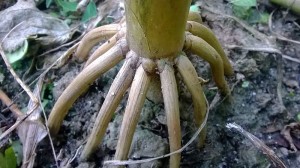 Roots serve many different functions. They build elaborate structures under the soil, around obstacles, along walls and trees, over water and in the air. They can get nutrients from the soil or the air. They grow supports (stilt roots) that branch down from lateral roots and others that pull bulbs deeper by expanding radially and contracting longitudinally. Roots are large and course or very fine. They have suckers (called haustoria in Dodder). They form special structures when chemicals are low such as dense rootlet clusters to gather rare phosphate. They form storage compartments for food or water.
Roots serve many different functions. They build elaborate structures under the soil, around obstacles, along walls and trees, over water and in the air. They can get nutrients from the soil or the air. They grow supports (stilt roots) that branch down from lateral roots and others that pull bulbs deeper by expanding radially and contracting longitudinally. Roots are large and course or very fine. They have suckers (called haustoria in Dodder). They form special structures when chemicals are low such as dense rootlet clusters to gather rare phosphate. They form storage compartments for food or water.
Basic Intelligent Qualities of Plants
 While it is not understood how roots could control many of the plant’s functions, a wide range of plant intelligent behaviors have been documented. Plants respond to environmental stimuli by movement, alteration of shape, and electrical and chemical signals. They use hormones for development, shape, and environmental changes. They compete for resources in the air and soil.
While it is not understood how roots could control many of the plant’s functions, a wide range of plant intelligent behaviors have been documented. Plants respond to environmental stimuli by movement, alteration of shape, and electrical and chemical signals. They use hormones for development, shape, and environmental changes. They compete for resources in the air and soil.
They calculate, make cost benefit decisions and control their measured responses to stressful circumstances. They have memory, can learn, and understand positive and negative experiences. They are territorial and understand self and family versus others. They process complex information and communicate long distances.
 Plants measure time, coordinating circadian clocks in leaf veins that communicate to the nearby cells and coordinate clocks in vessels and cells. There is more gene activity in the vessels in the evening than morning and the opposite in the cells. The vessel clocks control the leaf clocks.
Plants measure time, coordinating circadian clocks in leaf veins that communicate to the nearby cells and coordinate clocks in vessels and cells. There is more gene activity in the vessels in the evening than morning and the opposite in the cells. The vessel clocks control the leaf clocks.
Current research has uncovered many specific signals that produce decision-making in plants:
- Plants respond to light changes during different times of day including shade, length of day, seasons and daily circadian rhythms. Plants respond individually to the wavelengths of ultraviolet, green, far red, blue and red.
- Plants respond to temperatures in a variety of ways including the ability to calculate the number of days at specific temperature ranges. Plants respond to freezing with many defensive mechanisms.
 Plants respond to many mechanical factors including sound, wind, touch, being moved and shaken and other vibrations.
Plants respond to many mechanical factors including sound, wind, touch, being moved and shaken and other vibrations.
- Plants have elaborate mechanisms to respond to all aspects of water including too little, too much, and salt in water.
- Plants respond to gravity in a variety of ways including sending roots down and shoot up, as well as bending, and weight of branches.
- Plants can determine many qualities of soil including obstacles for roots, surface structures, and the elements in the soil such as clay, sand and stones.
- Plants respond to electricity and send electrical signals.
- Plants sense and distinguish differences between airborne chemicals including oxygen, CO2, mist, C2H4, NO. They help respond to nearby plants and roots, as well as predators.
- Plants sense and distinguish many chemicals and qualities including acidity and alkalinity, insecticides, calcium, heavy metals, potassium, boron, nitrates, and phosphates.
 Plants respond to their environment and space available. At times, they participate in re engineering of the environment, such as building up banks of soil. They are aware of and respond to plants that are nearby.
Plants respond to their environment and space available. At times, they participate in re engineering of the environment, such as building up banks of soil. They are aware of and respond to plants that are nearby.
- Plants are aware of their relatives and respond to them differently.
Recent Research in 2015
Plants Sense the Environment
The plant can be more aware of its environment because it is stuck there and cannot move. An animal can escape. Plants have 15 different photoreceptors to see the environment and they see the quality and the direction of the light. Animals have a smaller number.
Plants Have Short and Long Term Memory
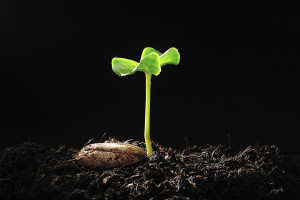 The many examples of plant long-term memory include mild stimuli that prepare plants for a much more severe attack later. The later assault would surely kill them without the warning signal and continued memory of their preparation of defenses.
The many examples of plant long-term memory include mild stimuli that prepare plants for a much more severe attack later. The later assault would surely kill them without the warning signal and continued memory of their preparation of defenses.
- Memory of cold in grasses lasts up to a year. The preparation by the plant allows better response to the cold.
- Drought produces lasting preparation.
- Plant preparation against diseases and chemicals used on plants can last for several years. This priming produces a much stronger reaction when the assault comes.
- It is hypothesized that epigenetic changes are used in this memory process.
Short term memory is noted in the Venus fly trap, which needs two touches in a 30 second period in order to close. It remembers the first with molecules being stored and on the second touch the amount of molecules becomes greater triggering the reaction.
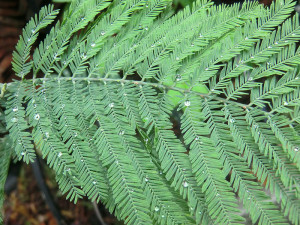
Mimosa has memory for a month. When first dropped onto foam, mimosa closed their leaves. After several further drops, they didn’t close them anymore because nothing terrible happened. They did close leaves when touched by a human hand. After a month they distinguished between the drop, with no closing, and the touch with closing.
Do Plants Feel Pain
Plants are aware of their environment and respond in many different ways. Some think plants feel pain. Ethylene is an anesthetic for humans and other animals, but plants manufacture it as a regulatory molecule. They produce more when they are stressed, such being attacked, eaten or cut. The plants near the damaged plant produce ethylene in response. When fruits are very ripe, a large amount of ethylene is produced.
Genetic Mechanisms
When a plant is cut or injured, it has developed a process of making multiple copies of all of its genes, so that they can immediately rebound with a different set of genes.
Light, rain, soil qualities, insects and grazing animals all produce specific transcription factors that trigger genetic switches.
Sensing Nitrogen
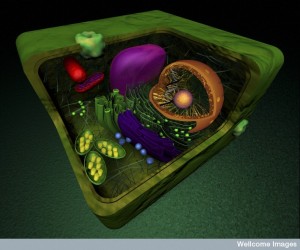 Nitrogen supply produces glutamine in chloroplast for nitrogen storage, later feeding it to different pathways. A special glutamine concentration sensor protein, present in all plants from algae and mosses to flowering plants, (PII) measures the amount of fuel available. PII produces signals for more amino acids when glutamine has a high concentration.
Nitrogen supply produces glutamine in chloroplast for nitrogen storage, later feeding it to different pathways. A special glutamine concentration sensor protein, present in all plants from algae and mosses to flowering plants, (PII) measures the amount of fuel available. PII produces signals for more amino acids when glutamine has a high concentration.
PII is a small loop that wraps around free glutamine molecules. Then, PII folds when there is sufficient amount and triggers metabolism.
Plants regulate symbiotic relationship with microbes
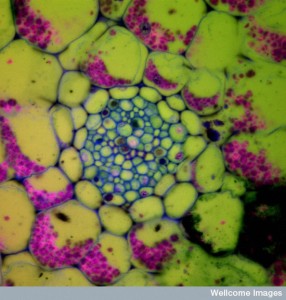 A new study shows that legume plants regulate their symbiotic relationship with soil bacteria by using cytokinins signaling molecules from shoots and leaves to root to control the amount of microbes in the nitrogen factories. The upward signal is peptides, the downward signal. The signal is perceived by kinase enzymes in the shoots, which produces an inhibitor of more roots. Maintains proper number of root factories.
A new study shows that legume plants regulate their symbiotic relationship with soil bacteria by using cytokinins signaling molecules from shoots and leaves to root to control the amount of microbes in the nitrogen factories. The upward signal is peptides, the downward signal. The signal is perceived by kinase enzymes in the shoots, which produces an inhibitor of more roots. Maintains proper number of root factories.
Plants Plan to Care for Offspring or Seedlings
Plants keep some of the seeds in the stem, and release the rest. When seed hunters like ants attack the plant, the plant seeds are kept safe and learn from the experience. When conditions for germination are better, then the seeds are released and are much stronger and safer.
They, also, share roots with their offspring ensuring a good start until they have strong enough roots.
Female ferns secrete gibberellin locally to other surrounding plants. This alters the local surrounding plants to become male providing better fertilization.
Grass Sends SOS Signals
 The scent of newly cut grass in recent years has been identified as the plant’s way of signaling distress, but new research says the aroma also summons beneficial insects to the rescue. The chemical signal attracts wasps to come to the plant being eaten and laying eggs on the pest insect.
The scent of newly cut grass in recent years has been identified as the plant’s way of signaling distress, but new research says the aroma also summons beneficial insects to the rescue. The chemical signal attracts wasps to come to the plant being eaten and laying eggs on the pest insect.
Fatty acid signals produce jasmonic acid starting defenses against insects and attract wasps to lay eggs in the caterpillar body.
Summary of Past Research
 The Dodder was described as, possibly, the most intelligent plant using taste, smell, movement and touch to manipulate other plants, and hijacking and transferring their genes. Dodder senses other plants at a long distance, grows to it, places a feeler and measures its nutrient levels. Dodder either pulls away or wraps around the plant and sucks out its nutrients and water with special haustoria. It, also, takes large molecules such as its DNA and RNA, including viruses. Dodder then passes this genetic information, including viruses to other plants. Dodder uses messenger RNA to track the condition of the plant or to alter it. (see post for more details of this process). This is similar to horizontal gene transfer with microbes.
The Dodder was described as, possibly, the most intelligent plant using taste, smell, movement and touch to manipulate other plants, and hijacking and transferring their genes. Dodder senses other plants at a long distance, grows to it, places a feeler and measures its nutrient levels. Dodder either pulls away or wraps around the plant and sucks out its nutrients and water with special haustoria. It, also, takes large molecules such as its DNA and RNA, including viruses. Dodder then passes this genetic information, including viruses to other plants. Dodder uses messenger RNA to track the condition of the plant or to alter it. (see post for more details of this process). This is similar to horizontal gene transfer with microbes.
Previous posts have demonstrated elaborate communication and defensive abilities of plants using senses of touch, sight, sound and smell. Plants exhibit elaborate problem solving, planning, communication, and defense with other plants, microbes and animals.
- Mathematical ability – Plants calculate the exact amount of sugar to last the night, even if light and sugar amounts are experimentally altered.
- Memory – Plants demonstrate short-term memory, immune memory and long-term memory across generations.
- Engineering – Plants can engineer their environment to increase survival – putting more soil in places and changing elevations.
- Elaborate Vision – Microscopic plants can see four different colors and send
 information about the four colors simultaneously giving them advantages in placing themselves at the right level for photosynthesis.
information about the four colors simultaneously giving them advantages in placing themselves at the right level for photosynthesis. - Altruism – Sagebrush when eaten by deer, grasshoppers and other predators signal other comrades with chemicals in the air to start defenses.
- Electric communication with bees – When bees land on flowers they change electrical potential. Flowers use bright color, smells and electricity to attract bees. Bees learn about the flower best from the electric signal.
Communication – Plants signal other plants by roots, air and either sound or magnetism. Plants respond to chemicals, contact, pressure, sound, gravity, light and possibly magnetism.
- Chili bean plants signal with either sound or magnetism to warn of the presence
 of the competitive fennel. Fruits signal others to increase ripening.
of the competitive fennel. Fruits signal others to increase ripening. - Fungal wires between plants send nutrients and information for mile in forests. Plants use them to warn of predators, but can cut them off, also.
Microbes Constant Communication with plants – A previous post described the detailed back and forth signaling with microbes, fungus and other plants to jointly build nitrogen factors in plants. Plants prepare specialized factories using“calcium signaling and major structural changes.
- The communication between plants and microbes includes more than chemical signaling. The mechanical force of a single fungus cell is registered by the plant as a signal. Plants sense friendly versus dangerous fungi. One touch can start cooperative signaling or resistance. If extreme danger is sensed, it kills the cells involved to save the plant.
Defense – Plants manufacture complex toxins to kill predators. The mustard plant plans ahead creating powerful toxins (dangerous to the plant in large quantities) just after dew 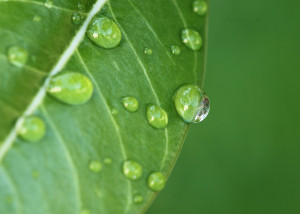 when the mold spores will land.
when the mold spores will land.
- Within five minutes, plants can release chemicals to attack predators.
- Plant bounce bats signals for them to come and eat the predator.
- Plants secrete poisons to kill insect eggs.
- Plants grow tumors to knock off the eggs.
- Plants secrete chemicals to influence insects’ behavior. Some will repel aphids, others will attract wasps to eat the aphids.
- When damaged by insects, tomatoes warn others by sending an airborne chemical that warns the other tomatoes. The chemical is then received by other tomatoes and altered to become a toxic chemical—it changed a signal into a
 weapon.
weapon. - When caterpillars eat leaves, the plant hears the vibrations, stimulating defensive chemicals. The vibration moved the plant ten thousands of an inch.
Intelligent War with DNA RNA self editing – An intelligent war rages between viruses and bacteria that have been described in other posts.
- Microbes use self-editing and mutations of genes to create new types of proteins that attack the processes that the virus and bacteria use. They use microRNA and other RNAs to block and silence genes and histones.
- Plants are able to self-edit DNA and RNA for different specific microbes. After microbe response, there are stronger responses including a large family of R proteins (R for resistance).
- Plants use viral RNA, make a double stranded copy and cut pieces to silence genes. After viral response, plants make specific suppressors.
RNA communication – Plants send RNAs to communicate between its own cells.
- RNAs travel long distances to control the shape of the leaves, when flowers will appear and how the root grows.
- These RNAs, silence particular genes affecting all of plant’s growth.
Plant Intelligence Primer and Update 2015
 As more research is done on plant behavior, their extraordinary abilities are coming into focus. Plants are able to synthesize many types of information and make intelligent decisions and adjustments. They, also, show care of young and family, altruism, and incredible memory. How can anyone doubt that plants are intelligent?
As more research is done on plant behavior, their extraordinary abilities are coming into focus. Plants are able to synthesize many types of information and make intelligent decisions and adjustments. They, also, show care of young and family, altruism, and incredible memory. How can anyone doubt that plants are intelligent?
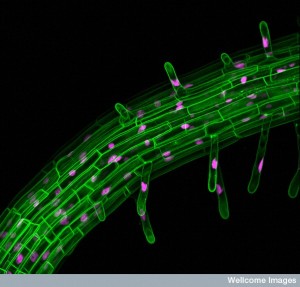

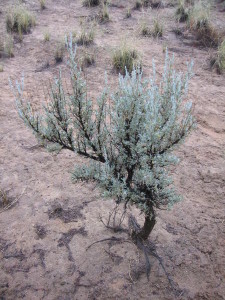
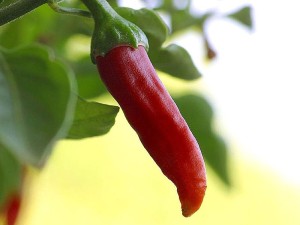 of the competitive fennel.
of the competitive fennel.